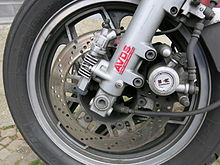Anti-dive
Among anti-dive is meant a device on wheeled vehicles, which the "immersion" during braking, that is, a pitching motion of the body forward through the dynamic wheel load is to prevent or reduce. It is also called brake buckling compensation .
Anti-dive in multi-lane vehicles
With the widespread independent suspension on double wishbones , the axles of the wishbones are inclined towards each other in order to achieve an anti-dive effect.
Anti-dive on motorcycles
In motorcycles there are mechanical or hydraulic systems that work on the telescopic fork . The first mechanical anti-dive systems appeared on racing motorcycles in 1979, among others at Kawasaki and Garelli . Hydraulic systems were first offered in production motorcycles by Suzuki and Yamaha in the early 1980s . In the early 1990s, all anti-dive systems disappeared from the market , also due to the appearance of the upside-down fork .
- Mechanical systems
- A pivoted rocker arm is taken along by the brake caliper of the disc brake during the braking process and is supported on the lower fork bridge with push struts . A higher maintenance requirement and an increased moment of inertia around the steering axis were found in racing machines. Mechanical systems were not used in series production.
- Hydraulic systems
- Brake line pressure is branched off via a short additional line and transferred from the brake caliper to a control piston. This control piston reduces the flow cross-section for the pressure stage of the telescopic fork and thus "hardens" the compression process. The designation for the anti-dive system was TRAC (Torque-Reactive-Antidive-Control) at Honda and AVDS (Automatic Variable Damping System) at Kawasaki
The mechanical anti-dive systems were more effective than the hydraulic anti-dive systems - comparable to the pushed swing arm . It was criticized that with hydraulic anti-dive systems - by throttling the compression damping - the effect was limited in time and the compression was delayed; harder spring identifications would be more effective.
Web links
Individual evidence
- ^ Jörnsen Reimpell, Jürgen W. Betzler: Fahrwerktechnik. Vogel Business Media, 5th edition 2005, ISBN 978-3-8343-3031-4 , p. 421
- ↑ http://performancetrends.com/Definitions/Anti-Dive.htm
- ↑ Jürgen Stoffregen: Motorcycle technology: Basics and concepts of engine, drive and chassis. Vieweg Verlag, Braunschweig, 7th edition 2010, ISBN 978-3-8348-0698-7 , p. 297
- ^ Helmut Werner Bönsch: Progressive motorcycle technology. 1st edition. Motorbuch Verlag Stuttgart 1985, ISBN 3-613-01054-2 , p. 234
- ^ Helmut Werner Bönsch: Progressive motorcycle technology. 1st edition. Motorbuch Verlag Stuttgart 1985, ISBN 3-613-01054-2 , p. 232
- ^ Helmut Werner Bönsch: Progressive motorcycle technology. 1st edition. Motorbuch Verlag Stuttgart 1985, ISBN 3-613-01054-2 , p. 235
- ↑ Jürgen Stoffregen: Motorcycle technology: Basics and concepts of engine, drive and chassis. Vieweg Verlag, Braunschweig, 7th edition 2010, ISBN 978-3-8348-0698-7 , p. 297
- ^ Helmut Werner Bönsch: Progressive motorcycle technology. 1st edition. Motorbuch Verlag Stuttgart 1985, ISBN 3-613-01054-2 , p. 237
